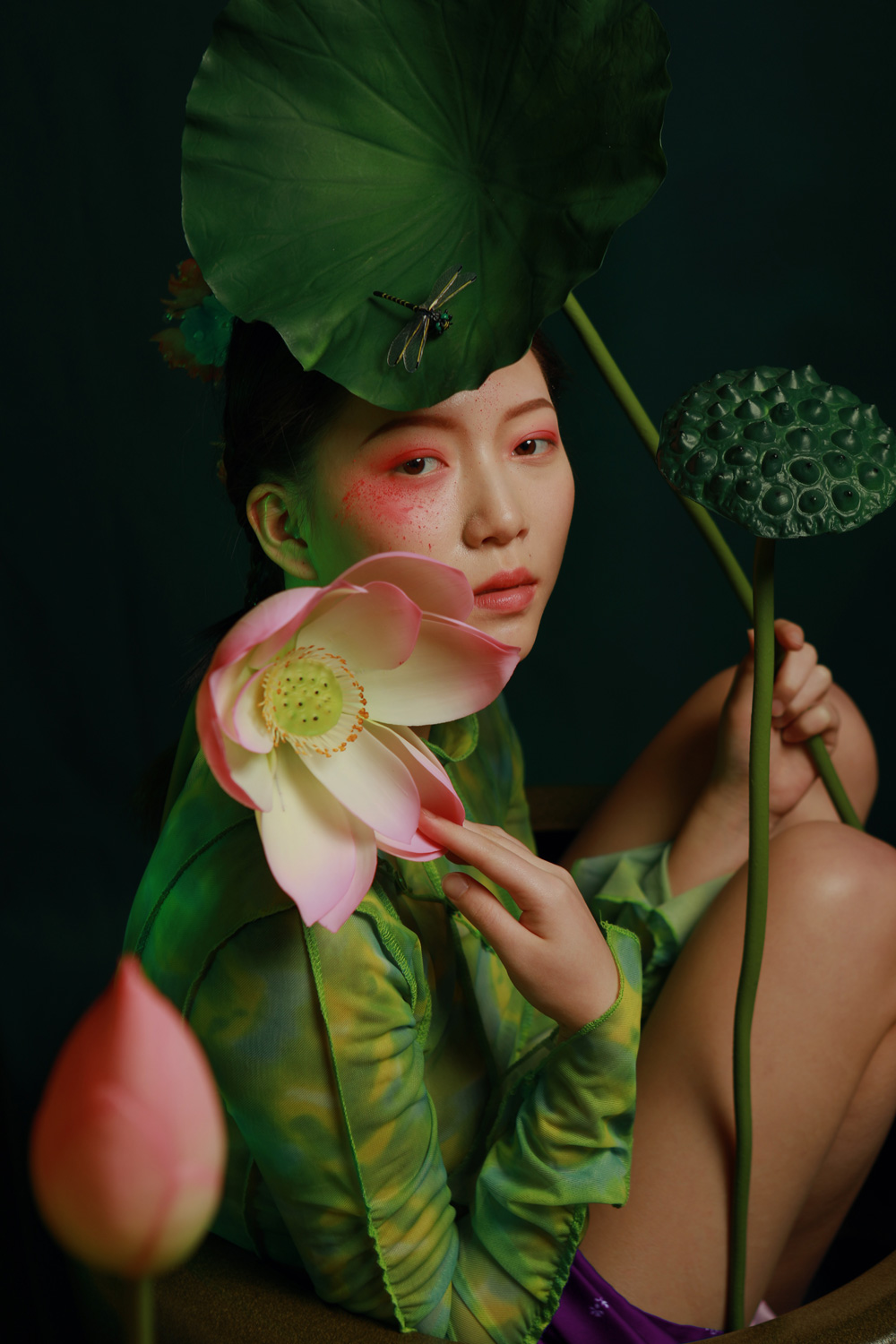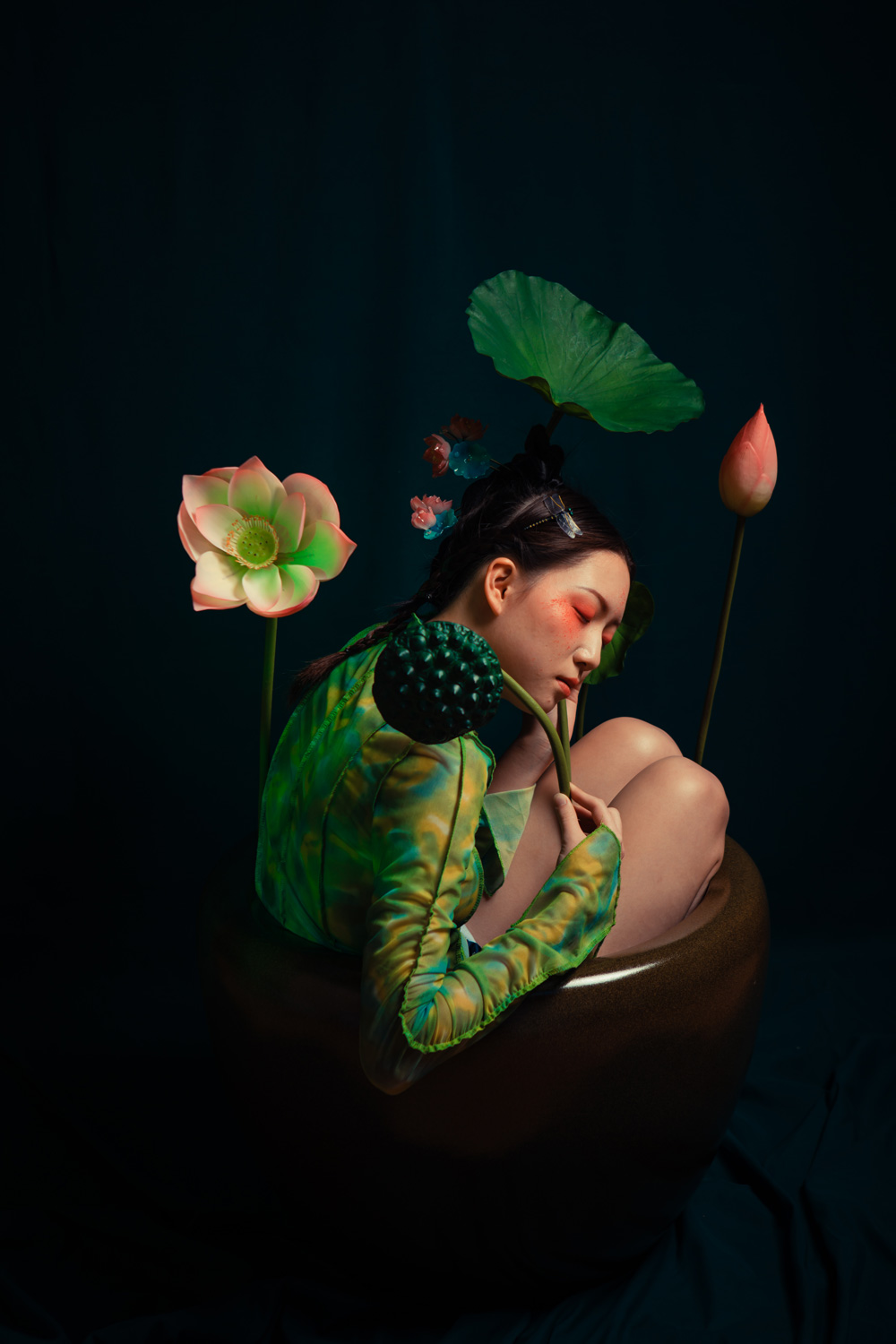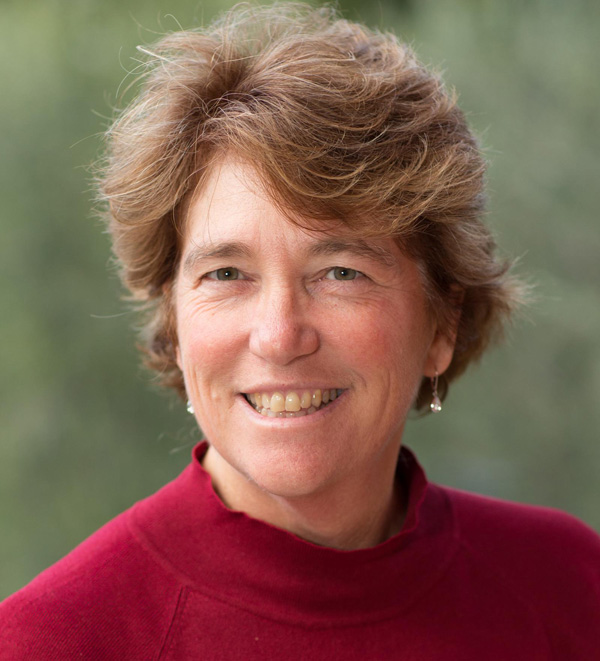

Lotus

Height: 18" x Width: 12" | Material(s): Lily, lily pads, dragonfly figure, lily-like clothes, red makeup
Process(es): Model holds pad with dragonfly, hand brushes flower, spirit looks into the camera | Idea(s): I took a big risk to strike out in a new direction: continue my investigations of lighting, magical realities, and fantasy transformations. | Curatorial Note: An enchanting piece of photography. This high-fashion photograph reflects the student’s sophistication in their understanding of the media, light, composition, and style.
Taolue Yu
Student statement
Student statement


AP 2-D
Sacred Heart Preparatory School
Atherton, CA, USA

Material(s): Lily, lily pads, dragonfly figure, lily-like clothes, red makeup | Process(es): Model holds pad with dragonfly, hand brushes flower, spirit looks into the camera
In what ways did your art-making confidence increase in AP Art and Design?
My confidence in artistic creation for AP Art and Design has been enhanced through several avenues. My Zen-style family garden design received recognition, boosting my confidence and ambition to establish a fashion brand, TAOLUE YU. Additionally, showcasing my work at events like Silicon Valley Fashion Week and receiving recognition in international photography competitions have reinforced my belief in my creative abilities. These experiences have cultivated my artistic confidence.
Did you participate in art shows at your school or in your community?
Yes, I participated in school and/or community art exhibitions almost every year from 9th to 12th grade. These platforms have allowed me to share my work with a broader audience, receive feedback, and connect with other artists and art enthusiasts.
Do you show your work through social media? If so, did you use feedback from social media account(s) to help you make decisions about your artwork?
My love for Zen and meditation has led to a profound appreciation for solitude and tranquility. As a result, I've opted to showcase my artistic creations exclusively on my personal website, steering clear of social media. However, I recognize that this preference for privacy might limit my growth, especially now that I've launched my own clothing line. Engaging with social media is crucial for enhancing the success and visibility of my business. I'm trying to find a balance that enables me to flourish both personally and professionally.

I found an opportunity to explore a new process: working with studio lights and a model, staging with props lying around the house, and exploring elements or motifs from my culture. Collaborating with my aunt on hair and makeup, we created a fantastical set with each image suggesting its own mysterious story.
How did your art teacher support your artistic development?
My art teacher Mr. Quinn has been supporting my artistic development by providing constructive feedback, encouraging experimentation, and fostering a creative environment. His guidance has been instrumental in honing my skills and pushing the boundaries of my artistic expression.
What is your advice to other AP Art and Design students?
My advice is to stay curious and open-minded. Embrace experimentation and take risks in your creative process. Let your unique experiences and inspirations guide your work, and don’t be afraid to showcase your individuality. Engage with the art community, seek feedback, and use it to fuel your growth. Most importantly, trust in your vision and remain passionate about your craft.
Moshe Quinn
Art Teacher and Co-Department Head of Fine Arts
Sacred Heart Preparatory, Atherton, CA, USA
Teacher statement
Teacher statement
The AP Art and Design course supports inquiry-based personalized learning in the sustained investigation portfolio component. What strategies helped you guide students through inquiry?
Often I start my students out with playful skills building. They see some new techniques, then I share some examples. These illustrate not just the techniques, but of course they also show creative expressions of particular themes or concepts. With these samples somewhere in the background, I invite my students to play, experiment, use their intuition, and see where the lights lead them. There’s often a prompt, but this can be very loose—not necessarily directing them as much as suggesting openings. Our first rounds of group critique play a key role: Where do we see some magic? What might these pieces suggest to us in terms of meaning? I think it’s important to listen to your work early on. Listen so you can hear what it’s telling you. You can see a direction it’s pointing you toward. After this intuitive process has time to unfold, we get more defined, more specific, more intentional. Even with direction, an adventurous spirit of experimentation is primary. That, and a mind open to recognizing what you see.
How did you scaffold writing into the art-making and thinking processes?
My students begin the year writing. And it’s kind of under the radar. I ask them to introduce their creative self to class with a slide presentation of their prior work. They need to add text for why they chose the images they chose, and what ideas or themes (might) come across in each piece. From there, the writing happens in different guises. But I am always steering written reflections—–and group critiques—to address essential uses of materials, meaningful choices for process, and expressing something about a theme. At the start of the second semester, they begin writing artist statements pegged to the prompts they will see for the AP Art portfolio. We do a good handful of iterations of these AP artist statements throughout the spring.
How did you structure practice, experimentation, and revision into your AP Art and Design curriculum?
Critiques occur about every three weeks. Sometimes it’s a cadence of two weeks. Each critique points to newly illuminated opportunities for further practice, trying out new things, new approaches to materials and/or process, a new inflection on the intended theme. Starting in the spring semester, for almost every critique there is the expectation of seeing a revision piece. Later in the spring, it’s two revision pieces.
What did you learn from working with your student?
Tao is so very individual. He became known and respected for gliding abstractedly across campus like he was riding a cloud. He was not generally talkative in class. But he was always very thoughtful and put a lot of effort into his art making. It was also very clear that he was easygoing about his work in a way. He wasn’t attached to a piece being “good” or not. He experimented and was interested to see what worked. He was easy about receiving criticism and feedback. He looked at all this as ongoing opportunities to learn, to see what could happen. This down-to-earth approach of his was very refreshing. I also learned that sometimes I need to listen more, or to create more opportunities for listening to my students. Sometimes they have a unique path they are on, and they might not feel secure about that. They might not know it’s welcome to go there. For a while Tao wasn’t sharing his art. Later I found out he was working on a project he didn’t think was relevant to our class because of its process. I’m sensitive to this possible situation now. I will do more from now on to frame the unlimitedness of possibility that is open to them.

Jennie Whitcomb
Principal
Sacred Heart Preparatory, Atherton, CA, USA
Leader Statement
Leader Statement
What are you most proud of regarding your school’s AP Art and Design program, student, and teacher?
I am most proud that our student, Taolue Yu, has been well supported by his teachers to create a body of work that has given him a chance to engage in sustained thinking about ideas that matter to him and that showcases his artistry and commitment to deepening his skills over time.
What do you do to support visual arts programming in your school?
Our school’s philosophy of education explicitly aims to “cultivate aesthetic values and creative use of the imagination.” We value visual arts because we recognize that we live in a world that communicates, ever more, in visual forms. All citizens need to be able to analyze visual images and to develop their understanding and skills in creating them. To support the visual arts, we offer an arts pathway from 9th to 12th grade. We require ninth graders to complete a Survey of the Arts course that offers opportunities to explore both visual and performing arts. Then, typically, in 10th grade, students complete a yearlong sequence, which for many focuses on the visual arts. After this yearlong sequence, students may enroll in advanced courses, including AP-level courses, that allow them to develop their artistic skills. We also celebrate the arts by holding two shows a year (one at the end of each semester), by weaving student art into community gatherings, and by publishing a literary/visual arts magazine annually.
What is your advice to other school leaders on how to support an AP Art and Design program?
I offer several strategies that have been effective for us: First, offer both formal and informal ways for students to experience the arts (e.g., clubs as well as credit-bearing courses). Second, conceptualize advanced courses as studio spaces. Third, encourage and support teachers to develop their craft as artists and to engage in professional development. Finally, build school community through intentional celebrations of the arts.

Taolue Yu
